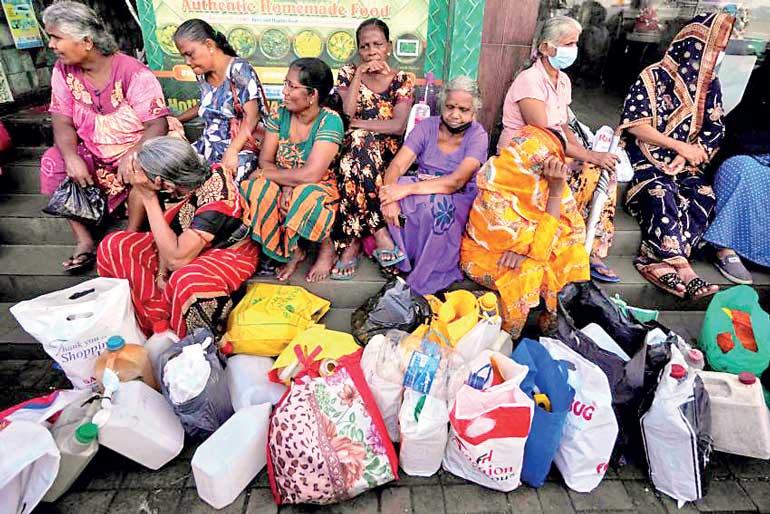Friday Dec 12, 2025
Friday Dec 12, 2025
Tuesday, 24 January 2023 00:00 - - {{hitsCtrl.values.hits}}

Sri Lanka’s continuing economic crisis as well as the policy responses taken to resolve the crisis are pushing the country into an ever-worsening recession, and causing disproportionate pain to the poor people, which is a significant majority of the population

Sri Lanka underwent an economic crisis in early 2022 and continued to be in the crisis with no apparent recovery. East Asia also went through an economic crisis in 1997 but recovered within a year. This note explains why the current macroeconomic policy package adopted in Sri Lanka may not yield an East Asian style recovery in Sri Lanka. The note also explains long-term strategies to stage a recovery similar to East Asia.
Sri Lanka’s continuing economic crisis as well as the policy responses taken to resolve the crisis are pushing the country into an ever-worsening recession, and causing disproportionate pain to the poor people, which is a significant majority of the population. The crisis arose from no fault of the people, but from wrong macroeconomic management and unsound foreign debt management exacerbated by a global energy shock.
The country must be in a deep recession as it suffered a massive supply side shock. High prices and uncertainty in availability of energy drove the economy away from its equilibrium. The aggregate demand must also have shrunk with deep depreciation of the currency and high inflation shock worsening the recession. The debt default must have been a further blow to the economy endangering any prospects of recovery and growth.
Major components of the macroeconomic policy package introduced to Sri Lanka to recover from the crisis are high interest rates, high taxes, administratively fixed exchange rates and import controls. This macroeconomic policy package seems to be having opposite effects.
High interest rates and high taxes discourage private investment. Unabated government expenditure crowds out private investment further. Maintaining a fixed exchange rate even after a deep depreciation generates uncertainty of its future and negatively affects the competitiveness of the country discouraging industrialisation. Import controls further strain consumption and industrial production. The combined result is to worsen the recession and send the economy spiralling down in a dark tunnel of high unemployment, high inflation, and abject poverty. According to recent reports, poor segments of the population already suffer from severe malnutrition, and the richer segments of the population attempt to migrate at the first available opportunity inhibiting human capital development.
A similar macroeconomic policy package was introduced to East Asian countries when they encountered a financial crisis in 1997. The policy package was a success in those countries unlike its failure in Sri Lanka. The reason is the vastly different characteristics between the economy of Sri Lanka and East Asian economies.
Unlike Sri Lanka, none of those countries defaulted on sovereign debt after the crisis, though private enterprises went through some foreign debt restructuring. None of the countries also went through fuel shortages that would have crippled their economies.
The East Asian crisis started in Thailand due to an overvalued exchange rate inviting a speculative attack on the Central Bank. The attack was a success, and the Thai Central Bank lost a substantial amount of its reserves by defending the overvalued currency. In the aftermath, the currency, Thai Baht, depreciated steeply and the country plunged into an economic crisis. The crisis spread over to several more East Asian countries. South Korea, Indonesia, Philippines, and Malaysia faced the most severe contagion effects, and Hong Kong and Singapore felt some effect. At that time Sri Lanka was fully insulated from the contagion because of the closed capital account, low exposure to foreign debt and realistic adjustments of the exchange rate to avoid any overvaluations.
East Asian countries were economic power houses when the crisis hit them. They were growing at rapid rates aided by excellent infrastructure development, human capital development, technology adaptation, high international competitiveness, relatively low degree of corruption and fully liberalised economies. In the process of liberalisation of their economies, they also had fully liberalised the capital account as per the advice of the International Monetary Fund (IMF).
This entailed those countries facing large capital inflows and outflows for investment as well as speculative purposes. As a result of capital account liberalisation, the banking system and major corporations were also heavily exposed to foreign debt. To maintain the viability of those banks and corporations East Asian countries were maintaining fixed exchange rates. At the same time those countries were pursuing independent monetary policy. The result of maintaining this ‘Impossible Trinity’ was inevitable speculative attacks by operators of large foreign funds.
The IMF came to the rescue immediately after the crisis with a policy package very similar to the package introduced to Sri Lanka. Interest rates were raised as a measure of tight monetary policy to prevent excessive depreciation of the currencies. It prevented the vicious cycle of depreciation and inflation. Fiscal policy was tightened by cutting government expenditure to curtail budget deficits. The IMF provided loans to meet immediate international finance needs. Structural reforms were also introduced in those countries to ensure policy transparency and political stability.
The policy package stabilised those economies and helped win back the investor confidence. Stable exchange rates after a large devaluation combined with high interest rates reversed the outflow of speculative capital and encouraged further inflow of capital back to those countries. After the stabilisation, tight macroeconomic policies were quickly relaxed to promote private investment, foreign direct investment and economic growth. The economies responded positively to the policies.
Economic growth was feasible because all growth promoting factors were already in place since those countries have been economic power houses prior to the crisis. Central banks in those countries learned their lessons and allowed the exchange rates to freely float to stem any more speculative attacks. All countries except Indonesia recovered faster than anyone expected. The recovery took only one year. However, in Indonesia a grave political crisis emerged, but the country recovered eventually.
The IMF and Sri Lanka’s policymakers may be expecting an East Asian style recovery. The Budget Speech 2023 of Sri Lanka indicates a recovery within the next 12 months, but falls short of explaining how the recovery would happen. However, it is unlikely that Sri Lanka would stage a similar recovery as a result of the current policy package.
In East Asia the policy package reversed the outflow of speculative capital providing a breathing space for those economies. In Sri Lanka such capital flows do not exist and the policy package is having unintended negative consequences. Sri Lanka borrowed long-term foreign funds incessantly at high interest rates, and did not invest those funds prudently. Sri Lanka may also not have had a foreign debt management system or debt sustainability framework which should have been put in place with the first instalment of commercial debt in 2007. Furthermore, Sri Lanka has been maintaining a fixed exchange rate regime by selling foreign exchange reserves for no comprehensible reasons. As a result, foreign currency became cheap, imports surged, industrialisation inhibited, and the trade deficit widened. To continue to maintain the fixed exchange rate and to finance the ever-widening trade deficit Sri Lanka kept on borrowing from international markets until its creditworthiness disappeared. At the dawn of 2022 it was impossible to borrow any more foreign currency.
Yet, for a few more months, Sri Lanka kept on using its foreign exchange reserves to maintain the fixed exchange rate until all reserves disappeared. After this happened, there was no means of financing essential imports such as fuel and meeting sovereign debt repayment obligations. In the aftermath the exchange rate had a free fall, imports of energy and essential goods stopped, and Sri Lanka defaulted on its sovereign debt for the first time. These culminated in Sri Lanka falling into a recession and population facing unprecedented hardships as if they had walked back to the Stone Age.
For a recovery, Sri Lanka has to earn foreign exchange through export promotion and industrialisation. For this to happen, Sri Lanka should relax macroeconomic policies to promote private investment and undertake structural reforms to remove obstacles to economic growth.
Sri Lanka has been lacking growth promoting forces even before the onset of the economic crisis. There are many reasons for the lack of those forces. Two of the summary indicators are global competitiveness and corruption perception. According to the World Economic Forum more than half the countries in the world are more competitive than Sri Lanka. Sri Lanka has been occupying this mediocre position ever since the country entered the competitiveness ranking. Their report clearly states where Sri Lanka is failing. Sri Lanka also occupies a mediocre position in the Corruption Perception Index published by the Transparency International. Only 78 countries in the whole world are more corrupt than Sri Lanka. It is not clear if the proposals in Budget 2023 could address these major shortcomings.
The way forward for recovery and long-term growth is to invent a suitable macroeconomic policy package, strengthen public policies that are necessary to stage an industrial revolution and rapid economic growth, regain competitiveness, eliminate corruption, strengthen institutions, strengthen the law and order, protect property rights, maintain economic stability, regulate unhealthy economic activities, and look after the poor and vulnerable sections of the population. However, none of those policies will be effective until strong measures of accountability and appropriate checks and balances are imposed on the government sector.
In the absence of those measures, the country will be pushed deeper into the crisis. It is also noteworthy that even if those measures are put in place, the country will prosper only if politicians and bureaucrats possess some entrepreneurial skills as well as skills to draw innovative strategies to propel the country to a high growth path.
(The writer has worked at the Central Bank of Sri Lanka as the Superintendent of Public Debt, Director of Economic Research, and an Assistant Governor. At present he teaches Economic Theory and Policy at the University of Iowa, USA. He may be contacted through [email protected].)